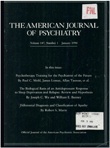Rapid cycling affective disorder: contributing factors and treatment responses in 51 patients
Abstract
For 51 patients with rapid cycling affective disorder, clinical and family history data indicated that the illness was phenotypically and genetically related to more typical forms of affective disorder, was characterized by a bipolar course (100%), and was more common in women (92%). Manic-depressive cycles were separate from menstrual cycles. At the time of onset of rapid cycling, 73% of the patients were taking antidepressant drugs; the continuation of rapid cycling was associated with antidepressant drug therapy in 51% of the patients. Although most patients had been referred to a research ward because they were considered to be refractory to treatment, 37% attained essentially complete remissions, usually during treatment with lithium and/or monoamine oxidase inhibitors.
Access content
To read the fulltext, please use one of the options below to sign in or purchase access.- Personal login
- Institutional Login
- Sign in via OpenAthens
- Register for access
-
Please login/register if you wish to pair your device and check access availability.
Not a subscriber?
PsychiatryOnline subscription options offer access to the DSM-5 library, books, journals, CME, and patient resources. This all-in-one virtual library provides psychiatrists and mental health professionals with key resources for diagnosis, treatment, research, and professional development.
Need more help? PsychiatryOnline Customer Service may be reached by emailing [email protected] or by calling 800-368-5777 (in the U.S.) or 703-907-7322 (outside the U.S.).



